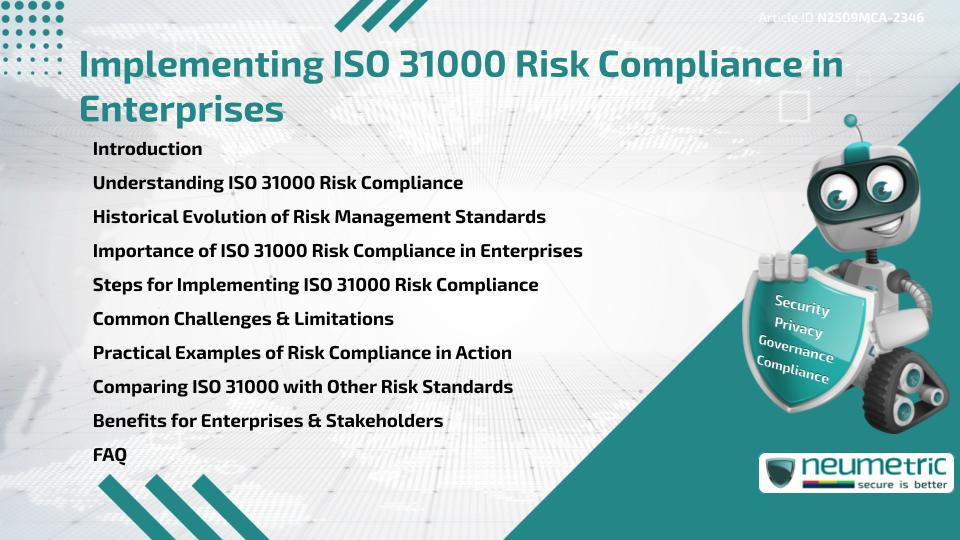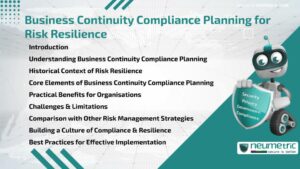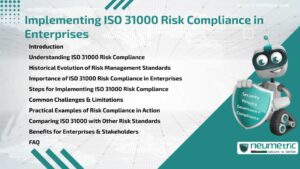Table of Contents
ToggleIntroduction
ISO 31000 Risk Compliance provides enterprises with a globally recognized Framework for managing Risk in a structured & efficient manner. By adopting this Standard, Organisations can enhance decision-making, build Stakeholder confidence & strengthen operational resilience. This article explores the historical roots, practical steps, challenges & benefits of ISO 31000 Risk Compliance, offering enterprises a clear roadmap for effective implementation.
Understanding ISO 31000 Risk Compliance
ISO 31000 is an International Standard developed by the International Organisation for Standardization [ISO] to provide guidelines for Risk Management. Risk compliance under this Framework ensures that enterprises establish structured processes to identify, assess & mitigate Risks. Unlike prescriptive Standards, ISO 31000 is adaptable to Organisations of different sizes & industries, making it a flexible tool for enterprise-wide Risk Management.
Historical Evolution of Risk Management Standards
The roots of ISO 31000 Risk Compliance lie in the broader evolution of Corporate Governance & enterprise Risk Management practices. In the early twentieth century, businesses primarily focused on insurable Risks. With globalization, complex Supply Chains & Technological advancements, Organisations realized the need for broader Risk Frameworks. ISO 31000 was introduced in 2009, revised in 2018 & has since become a cornerstone in enterprise Risk practices, complementing other Governance & compliance initiatives.
Importance of ISO 31000 Risk Compliance in Enterprises
Why should enterprises prioritise ISO 31000 Risk Compliance? The answer lies in its holistic approach to managing both internal & external uncertainties. By applying this Standard, companies can:
- Improve resilience against unexpected events
- Create consistent decision-making processes
- Enhance Stakeholder trust
- Align with legal & regulatory expectations
ISO 31000 bridges the gap between theoretical Risk concepts & real-world business applications, making Risk Management a strategic tool rather than just a compliance requirement.
Steps for Implementing ISO 31000 Risk Compliance
Enterprises seeking to adopt ISO 31000 Risk Compliance can follow these steps:
- Leadership Commitment: Secure buy-in from Senior Management.
- Establish Context: Define organizational objectives, Stakeholders & external factors.
- Risk Identification: Recognize potential internal & external Risks.
- Risk Assessment: Evaluate the Likelihood & Impact of Risks.
- Risk Treatment: Develop mitigation strategies & response plans.
- Communication & Consultation: Keep Stakeholders informed & engaged.
- Monitoring & Review: Continuously evaluate Risk performance & adapt strategies.
These steps help enterprises embed Risk Management into their daily operations, ensuring long-term sustainability.
Common Challenges & Limitations
While ISO 31000 Risk Compliance offers a strong Framework, enterprises may face hurdles during implementation. These include:
- Limited awareness or training among staff
- Resistance to cultural change
- Difficulty in quantifying intangible Risks
- Integration challenges with existing compliance programs
Overcoming these requires sustained leadership support, Employee engagement & gradual cultural transformation.
Practical Examples of Risk Compliance in Action
A Manufacturing company might use ISO 31000 to address supply chain disruptions by identifying critical suppliers & creating contingency plans. Similarly, a Financial institution could adopt the Framework to manage Cybersecurity Threats, ensuring robust monitoring & Incident Response. These examples show how ISO 31000 adapts to different sectors, offering universal value in Risk handling.
Comparing ISO 31000 with Other Risk Standards
Unlike sector-specific Standards such as ISO 27005 for Information Security Risk Management or COSO ERM for enterprise Risk Management, ISO 31000 provides a high-level, principle-based Framework. Its adaptability allows enterprises to align it with other Standards without duplication, making it a versatile choice for Organisations seeking to unify Risk practices.
Benefits for Enterprises & Stakeholders
Enterprises adopting ISO 31000 Risk Compliance gain multiple benefits:
- Enhanced resilience in volatile markets
- Improved reputation among clients & investors
- Stronger alignment with corporate Governance principles
- Efficient use of resources in managing Risks
For Stakeholders, this translates into greater confidence that the enterprise can withstand uncertainties & continue to deliver value.
Takeaways
- ISO 31000 Risk Compliance provides a flexible, principle-based Framework for enterprise Risk Management.
- Implementation requires leadership commitment, structured processes & cultural adoption.
- The Standard offers broad benefits including resilience, trust & Governance alignment.
- Despite challenges, enterprises that embrace ISO 31000 strengthen long-term sustainability.
FAQ
What is ISO 31000 Risk Compliance?
It is the application of ISO 31000 guidelines to ensure Organisations manage Risks through structured & principle-based processes.
How does ISO 31000 differ from other Risk Standards?
ISO 31000 is principle-based & adaptable to all industries, whereas other Standards like COSO ERM or ISO 27005 are more specific in scope.
Why is ISO 31000 Risk Compliance important for enterprises?
It improves resilience, supports better decision-making & builds Stakeholder trust by addressing Risks systematically.
What are common challenges in implementing ISO 31000?
Challenges include lack of awareness, cultural resistance & difficulties integrating with existing compliance systems.
Can ISO 31000 be used with other Frameworks?
Yes, ISO 31000 can complement other Frameworks by providing a high-level Risk Management structure that aligns with specific Standards.
Is ISO 31000 applicable to Small Businesses?
Yes, ISO 31000 is scalable & can be applied by both large enterprises & small Organisations.
How often should Risk Assessments be reviewed under ISO 31000?
Risk Assessments should be regularly reviewed, especially when there are significant internal or external changes.
References
- International organisation for Standardization – ISO 31000 Overview
- Harvard Law School Forum – Corporate Governance & Risk Management
Need help for Security, Privacy, Governance & VAPT?
Neumetric provides organisations the necessary help to achieve their Cybersecurity, Compliance, Governance, Privacy, Certifications & Pentesting needs.
Organisations & Businesses, specifically those which provide SaaS & AI Solutions in the Fintech, BFSI & other regulated sectors, usually need a Cybersecurity Partner for meeting & maintaining the ongoing Security & Privacy needs & requirements of their Enterprise Clients & Privacy conscious Customers.
SOC 2, ISO 27001, ISO 42001, NIST, HIPAA, HECVAT, EU GDPR are some of the Frameworks that are served by Fusion – a SaaS, multimodular, multitenant, centralised, automated, Cybersecurity & Compliance Management system.
Neumetric also provides Expert Services for technical security which covers VAPT for Web Applications, APIs, iOS & Android Mobile Apps, Security Testing for AWS & other Cloud Environments & Cloud Infrastructure & other similar scopes.
Reach out to us by Email or filling out the Contact Form…





